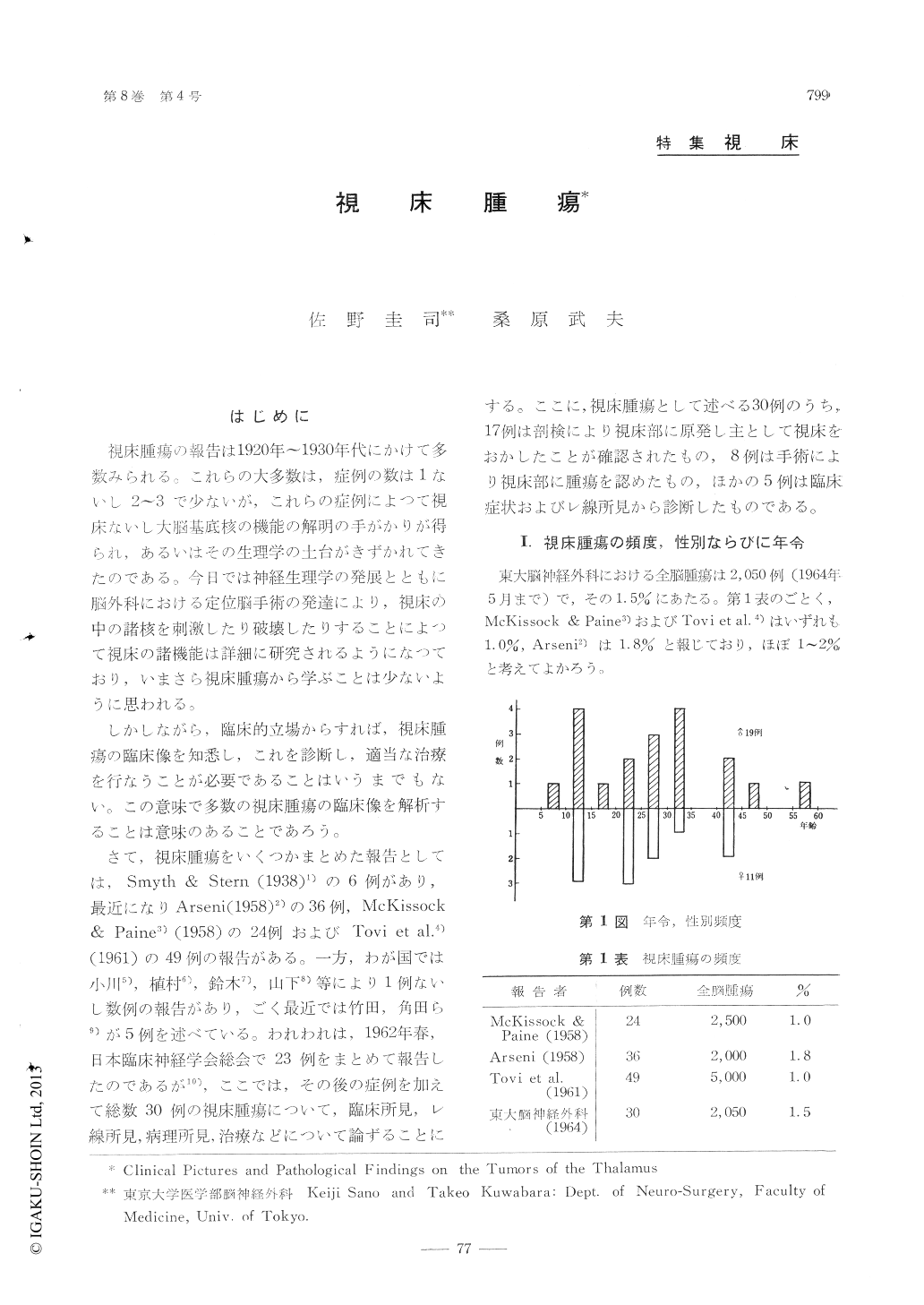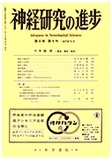Japanese
English
- 有料閲覧
- Abstract 文献概要
- 1ページ目 Look Inside
はじめに
視床腫瘍の報告は1920年〜1930年代にかけて多数みられる。これらの大多数は,症例の数は1ないし2〜3で少ないが、これらの症例によつて視床ないし大脳基底核の機能の解明の手がかりか得られ,あるいはその生理学の土台がきずかれてきたのである。今日では神経生理学の発展とともに脳外科における定位脳手術の発達により,視床の中の諸核を刺激したり破壊したりすることによつて視床の諸機能は詳細に研究されるようになつており,いまさら視床腫瘍から学ぶことは少ないように思われる。
しかしながら、臨床的立場からすれば,視床腫瘍の臨床像を知悉し,これを診断し,適当な治療を行なうことが必要であることはいうまでもない。この意味で多数の視床腫瘍の臨床像を解析することは意味のあることであろう。
Clinical pictures and pathological findings of 30patients with tumors of the thalamus were outlined.
The present series of 30 patients with thalamictumors were detected out of a total of 2,050 braintumors admitted in our clinic; indicating an inci-dence of 1.5%. These patients were comprised of 19men and 11 women, the age of them varied from 8to 58 years, with the mean of 26 years at the timeof admission and the duration of symptoms beforeadmission was usually short-half of the patientswith symptoms of less than 6 months.
As an initial symptom, headache was complainedmainly in 16 patients and in a few cases, diplopia,tremor, general fatigue, mental change etc werestated respectively. Sometimes headache was ofsome characteristics in nature-suddenly occuringintermittent severe headache.
The following clinical symptoms were recorded;increased intracranial pressure symptoms in 97% ofcases (29 out of 30), hemiplegia or hemiparesis in57% (17 cases), tremor in 37% (11 cases) andincoordination in 63% (19 cases).
Sensory disturbances were noted in 13 cases (48%); however, almost all of them were super-ficial in type and the spontaneous pain or excessiveresponse to stimulation which were assumed to becharacteristic features of thalamic lesion werenoted in only 4 cases.
Various types of epileptic seizures were expe-rienced by 11 patients (41%).
Ocular signs or visual defects excluding abd-ucens palsy or decrease in visual acuity resultingfrom increased intracranial pressure, were notedin 17 cases (57%).
Anisocoria was seen in 11 patients; in 7 casesthe tumor was located on the side of the smallerpupil and in the remaining 4 cases, just the con-trary was observed. And the neural mechanismsof this phenomenon were discussed.
Psychic symptoms were noted in 17 patients(57%), in which memory disturbance, mentaldeterioration, disorientation and hypersomnia werefrequently encountered.
Endocrine disturbances were noted in 4 patients,tinnitus in 9, and decrease of auditory acuity in 4.
Clinical picture of the patients can be dividedinto three groups; the first group with psychicsymptoms as main component, the second groupwith incoordination, and the third group withhemiplegia or hemiparesis and sensory disturbance.These groups correspond to the medial, the antero-lateral and the postero-lateral thalamic syndromesrespectively.
EEG was examined in 10 patients and in allcases some abnormal findings were recorded whichshowed the presence of subcortical deep lesion.
Pneumoventriculogram which showed the charac-teristic picture was extremely reliable as a diagn-ostic measure and sometimes cerebral phlebographyalso revealed some significant features.
Surgical intervention such as subtotal or partialremoval of the tumor, decompressive craniotomyor shunt operation were carried out on 24 patientswith mortality of 12 cases. It was indeed unfortunateto observe frequently, the striking appearance ofserious brain edema as a postoperative complicationafter a minor surgical procedure such as pneu-mov entriculography or Torkildsen's procedure.
In 21 patients, the diagnosis was confirmed hist-ologically. Astrocytoma was seen in 8 cases, glio-blastoma in 6, oligodendroglioma in 3, spongiobl-astoma in 2 and the last two turned out to be an epenclymoma and an angioulioma.

Copyright © 1964, Igaku-Shoin Ltd. All rights reserved.


